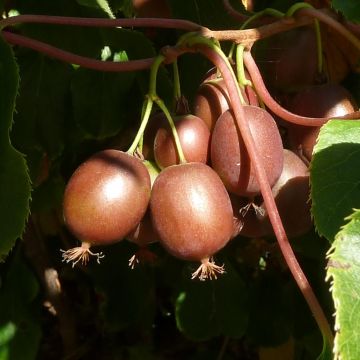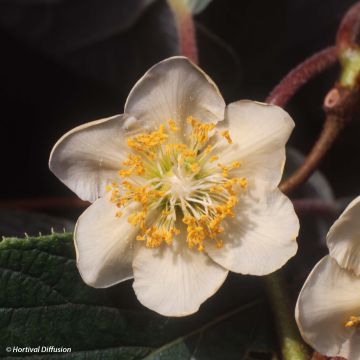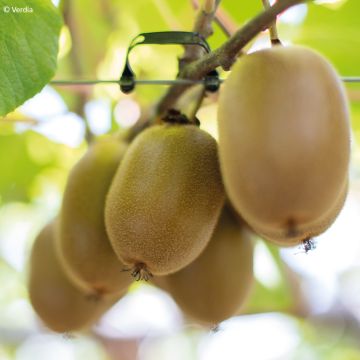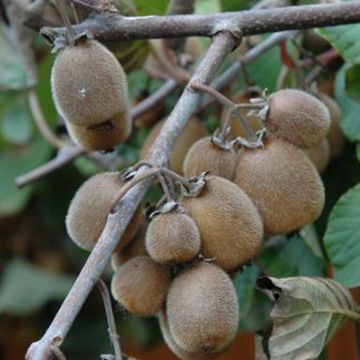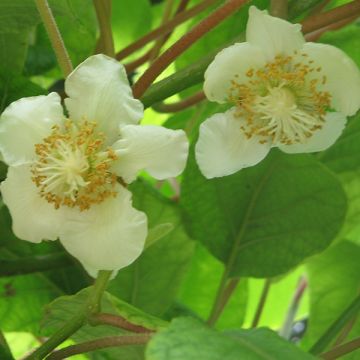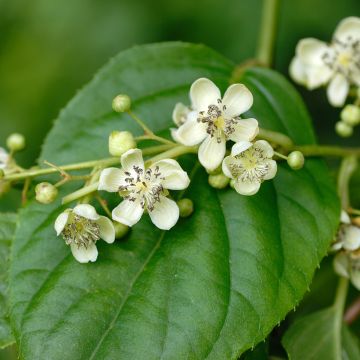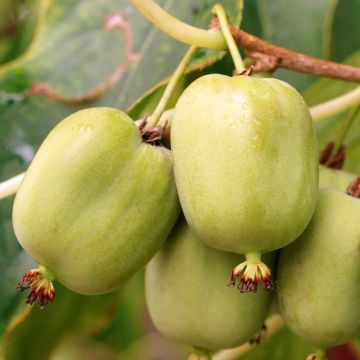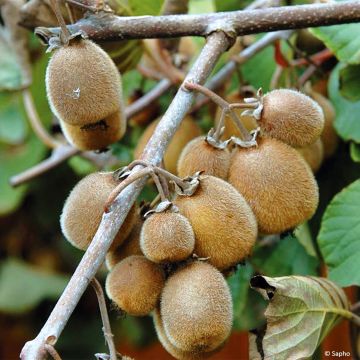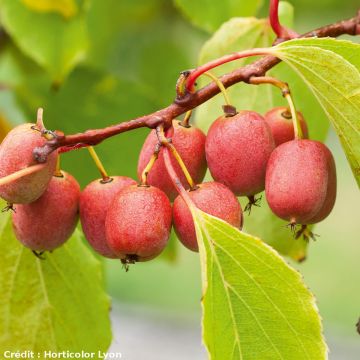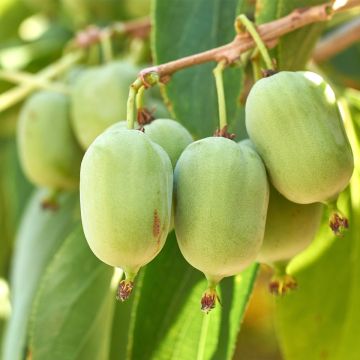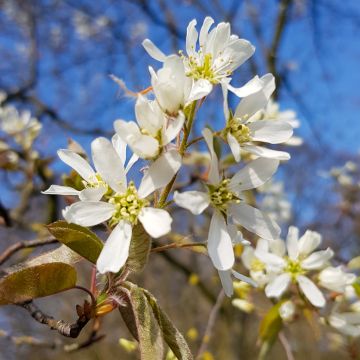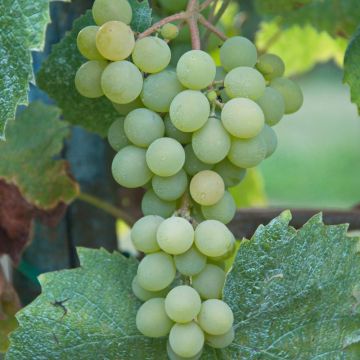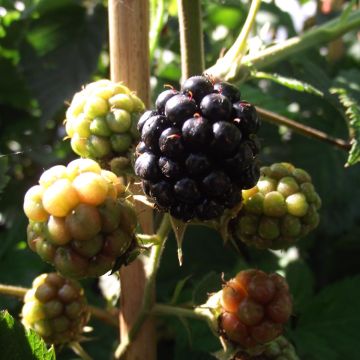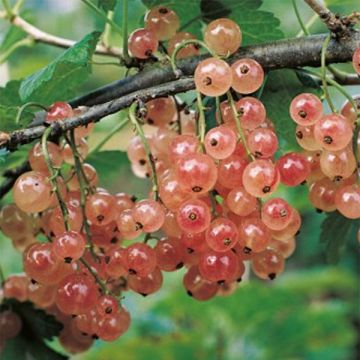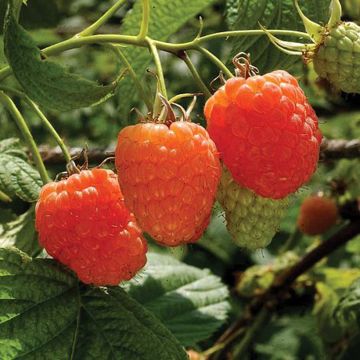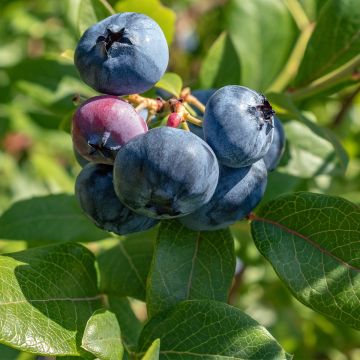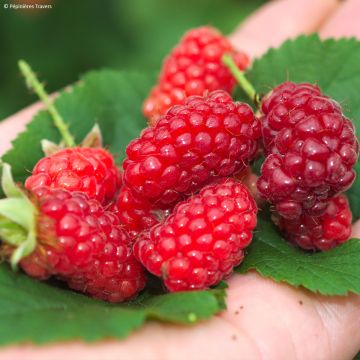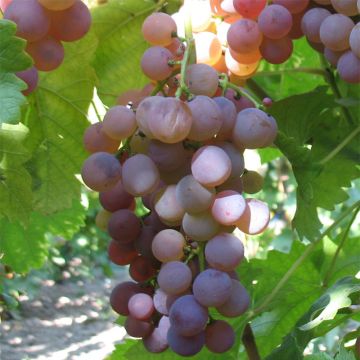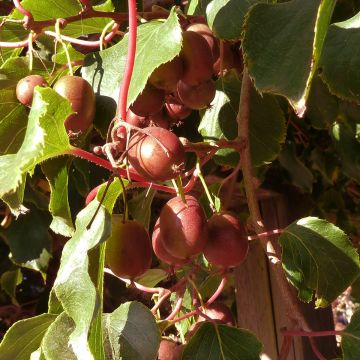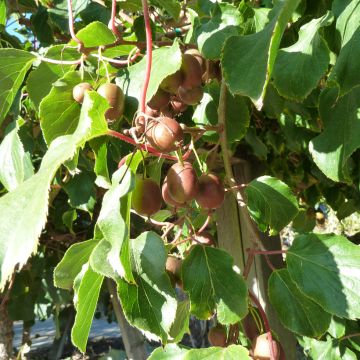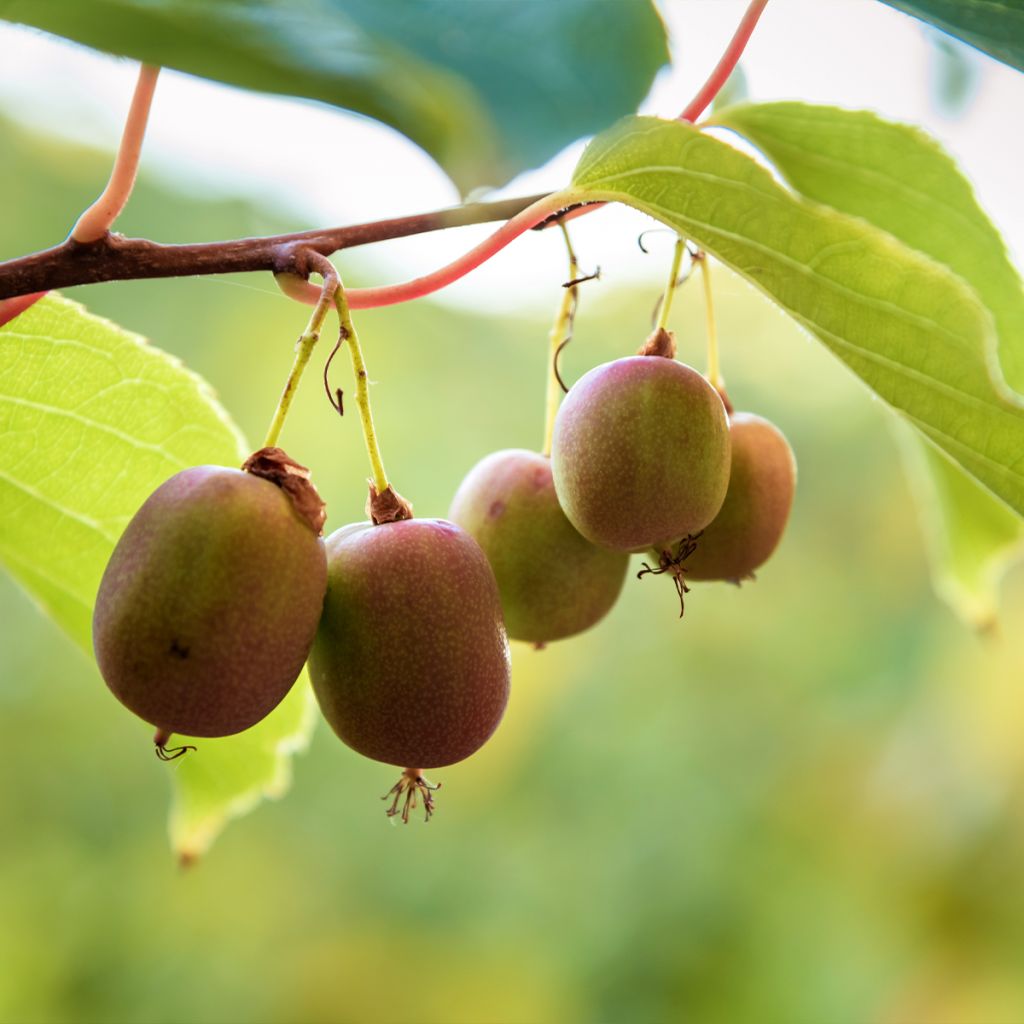

Hardy Kiwi Ananasnaya (female) - Actinidia arguta
Hardy Kiwi Ananasnaya (female) - Actinidia arguta
Actinidia arguta Ananasnaya
Hardy Kiwi, Tara Vine, Kiwai, Kiwiberry, Grape Kiwi
This item cannot be shipped to the selected country
Delivery charge from €5.90
Delivery charge from €5.90
More information
Schedule delivery date,
and select date in basket
This plant carries a 6 months recovery warranty
More information
We guarantee the quality of our plants for a full growing cycle, and will replace at our expense any plant that fails to recover under normal climatic and planting conditions.
From €5.90 for pickup delivery and €6.90 for home delivery
Express home delivery from €8.90.
From €5.90 for pickup delivery and €6.90 for home delivery
Express home delivery from €8.90.
Description
The Ananasnaya arguta Kiwai, also known as Anna Kiwai, generously produces fruits with a taste of pineapple. Like grapes, the smooth and thin skin of the Kiwai can be eaten whole. Extremely tasty and melting in the mouth, the bright green flesh is juicy and its flavours are sweet, tropical, and fruity. This female variety requires the presence of a male plant nearby for pollination. Originally from Poland, this very hardy variety of mini-kiwi produces green fruits that turn red on the sun-exposed sides, from September to early October.
In the Kiwi category, you can find the ornamental Kiwi (Actinidia kolomikta), the Kiwi (Actinidia chinensis or deliciosa) with fuzzy skin, and the Kiwi (Actinidia arguta) with smooth skin also known as Siberian Kiwi or Kiwai. All three belong to the Actinidiaceae family. The Ananasnaya arguta Kiwai (female) is a new Polish cultivar that produces long branches that can reach 4 to 6 metres (13 to 20 feet) in length. The branches bear deciduous leaves measuring 8 to 10cm (3 to 4in) in length, green, and heart-shaped, which fall in autumn. In June-July, fragrant and nectar-rich flowers appear at the axils of the leaves, cream-white in colour with purple anthers, grouped in threes. The oval-shaped fruits, measuring 2 to 3cm (1in) in diameter and 3cm (1in) in length, with smooth and thin skin, ripen in September-October. They can be stored for one to two weeks after picking. Its green, sweet, fragrant, and slightly acidic flesh tastes like pineapple, with tropical and lemon flavours. It is rich in calcium and vitamin C. It can be consumed whole. Fruiting begins 2 to 3 years after planting. The female Ananasnaya arguta Kiwai can be pollinated by the Weiki arguta Kiwai (male). Like the Kiwi, one male plant can fertilise 4 to 5 female plants.
In addition to its fruit qualities, its luxuriant foliage, fragrant flowering, and generous branches make the Kiwai a useful ornamental plant in the garden. This plant needs to be trained on a sturdy support such as wires stretched on a frame, a trellis, a pergola, an arbour, or a fence. It prefers light, slightly moist, lime-free soil and a sunny exposure.
You can consume and enjoy the fruits straight from the garden. They can also be stored for up to two weeks in the refrigerator. Production can reach up to 30 to 50kg per plant. The Kiwai can be eaten fresh, its flavour is refreshing and melting, a true delight. It can be enjoyed in pies, fruit salads, dairy desserts, jams, jellies, compotes, fruit juices, and cocktails. As a sweet vegetable, it can tenderly accompany white meat dishes.
Report an error about the product description
Hardy Kiwi Ananasnaya (female) - Actinidia arguta in pictures
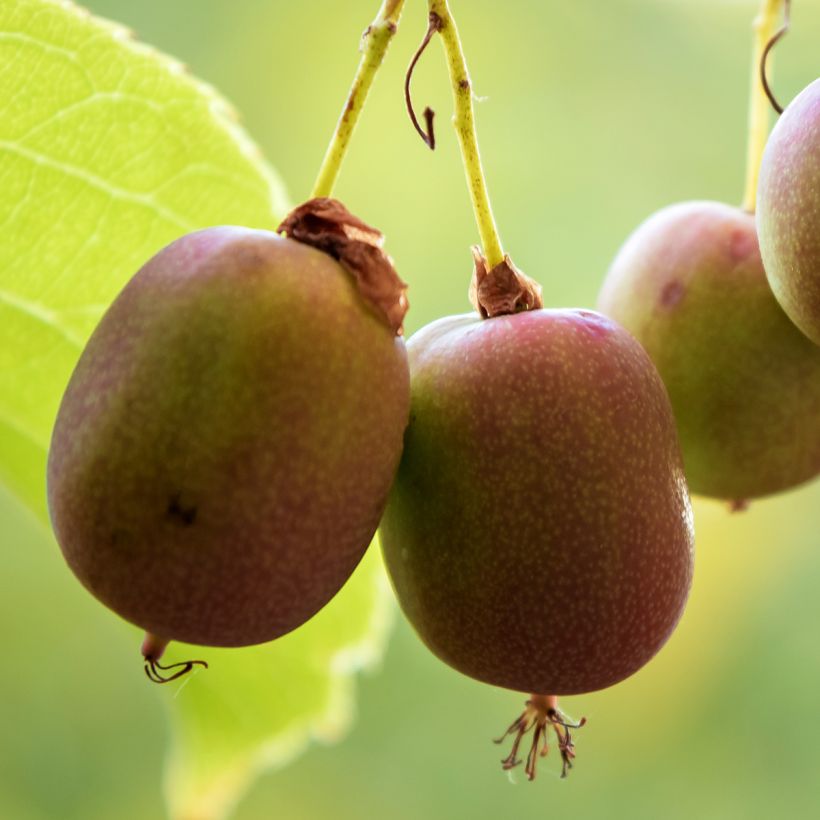

Plant habit
Fruit
Flowering
Foliage
Botanical data
Actinidia
arguta
Ananasnaya
Actinidiaceae
Hardy Kiwi, Tara Vine, Kiwai, Kiwiberry, Grape Kiwi
Actinidia arguta 'Anna'
Cultivar or hybrid
Other Kiwi bush
Planting and care
The Ananasnaya kiwai should be planted in neutral to acidic soil, slightly moist, rich, light, and well-drained, the plant dislikes stagnant moisture. Plant it in a sunny position sheltered from strong winds. Dig a hole 50cm (20in) in all directions. Spread a layer of gravel in the bottom, then a layer of soil mixed with compost. Lay the root ball diagonally and bring the stems upright along the support. Backfill with the same mixture. Provide support to help its branches climb. Add half a watering can of water. The kiwai has trailing roots, which develop horizontally below the soil surface. The soil must remain moist in summer, so it will be useful to mulch the base with a layer of 10 to 15cm (4 to 6in). Doubly useful, mulching prevents the germination of weeds and prevents water evaporation from the soil surface, reducing the need for watering in summer.
This kiwai requires little maintenance, simply provide regular watering. During periods of high heat, water it 1 to 2 times a week. Once established and rooted, the plant can fend for itself and becomes less water-hungry. Apply a fertiliser rich in bonemeal at the start of vegetation growth. A special fruit tree fertiliser will also be very beneficial during the flowering period.
Not very sensitive to insects and pests, Actinidia arguta Ananasnaya can still be affected by red spider mites in a hot and dry environment. To eliminate them, you can lightly and regularly spray water on the foliage and soil.
Planting period
Intended location
Care
This item has not been reviewed yet - be the first to leave a review about it.
Berries
Haven't found what you were looking for?
Hardiness is the lowest winter temperature a plant can endure without suffering serious damage or even dying. However, hardiness is affected by location (a sheltered area, such as a patio), protection (winter cover) and soil type (hardiness is improved by well-drained soil).

Photo Sharing Terms & Conditions
In order to encourage gardeners to interact and share their experiences, Promesse de fleurs offers various media enabling content to be uploaded onto its Site - in particular via the ‘Photo sharing’ module.
The User agrees to refrain from:
- Posting any content that is illegal, prejudicial, insulting, racist, inciteful to hatred, revisionist, contrary to public decency, that infringes on privacy or on the privacy rights of third parties, in particular the publicity rights of persons and goods, intellectual property rights, or the right to privacy.
- Submitting content on behalf of a third party;
- Impersonate the identity of a third party and/or publish any personal information about a third party;
In general, the User undertakes to refrain from any unethical behaviour.
All Content (in particular text, comments, files, images, photos, videos, creative works, etc.), which may be subject to property or intellectual property rights, image or other private rights, shall remain the property of the User, subject to the limited rights granted by the terms of the licence granted by Promesse de fleurs as stated below. Users are at liberty to publish or not to publish such Content on the Site, notably via the ‘Photo Sharing’ facility, and accept that this Content shall be made public and freely accessible, notably on the Internet.
Users further acknowledge, undertake to have ,and guarantee that they hold all necessary rights and permissions to publish such material on the Site, in particular with regard to the legislation in force pertaining to any privacy, property, intellectual property, image, or contractual rights, or rights of any other nature. By publishing such Content on the Site, Users acknowledge accepting full liability as publishers of the Content within the meaning of the law, and grant Promesse de fleurs, free of charge, an inclusive, worldwide licence for the said Content for the entire duration of its publication, including all reproduction, representation, up/downloading, displaying, performing, transmission, and storage rights.
Users also grant permission for their name to be linked to the Content and accept that this link may not always be made available.
By engaging in posting material, Users consent to their Content becoming automatically accessible on the Internet, in particular on other sites and/or blogs and/or web pages of the Promesse de fleurs site, including in particular social pages and the Promesse de fleurs catalogue.
Users may secure the removal of entrusted content free of charge by issuing a simple request via our contact form.
The flowering period indicated on our website applies to countries and regions located in USDA zone 8 (France, the United Kingdom, Ireland, the Netherlands, etc.)
It will vary according to where you live:
- In zones 9 to 10 (Italy, Spain, Greece, etc.), flowering will occur about 2 to 4 weeks earlier.
- In zones 6 to 7 (Germany, Poland, Slovenia, and lower mountainous regions), flowering will be delayed by 2 to 3 weeks.
- In zone 5 (Central Europe, Scandinavia), blooming will be delayed by 3 to 5 weeks.
In temperate climates, pruning of spring-flowering shrubs (forsythia, spireas, etc.) should be done just after flowering.
Pruning of summer-flowering shrubs (Indian Lilac, Perovskia, etc.) can be done in winter or spring.
In cold regions as well as with frost-sensitive plants, avoid pruning too early when severe frosts may still occur.
The planting period indicated on our website applies to countries and regions located in USDA zone 8 (France, United Kingdom, Ireland, Netherlands).
It will vary according to where you live:
- In Mediterranean zones (Marseille, Madrid, Milan, etc.), autumn and winter are the best planting periods.
- In continental zones (Strasbourg, Munich, Vienna, etc.), delay planting by 2 to 3 weeks in spring and bring it forward by 2 to 4 weeks in autumn.
- In mountainous regions (the Alps, Pyrenees, Carpathians, etc.), it is best to plant in late spring (May-June) or late summer (August-September).
The harvesting period indicated on our website applies to countries and regions in USDA zone 8 (France, England, Ireland, the Netherlands).
In colder areas (Scandinavia, Poland, Austria...) fruit and vegetable harvests are likely to be delayed by 3-4 weeks.
In warmer areas (Italy, Spain, Greece, etc.), harvesting will probably take place earlier, depending on weather conditions.
The sowing periods indicated on our website apply to countries and regions within USDA Zone 8 (France, UK, Ireland, Netherlands).
In colder areas (Scandinavia, Poland, Austria...), delay any outdoor sowing by 3-4 weeks, or sow under glass.
In warmer climes (Italy, Spain, Greece, etc.), bring outdoor sowing forward by a few weeks.

































